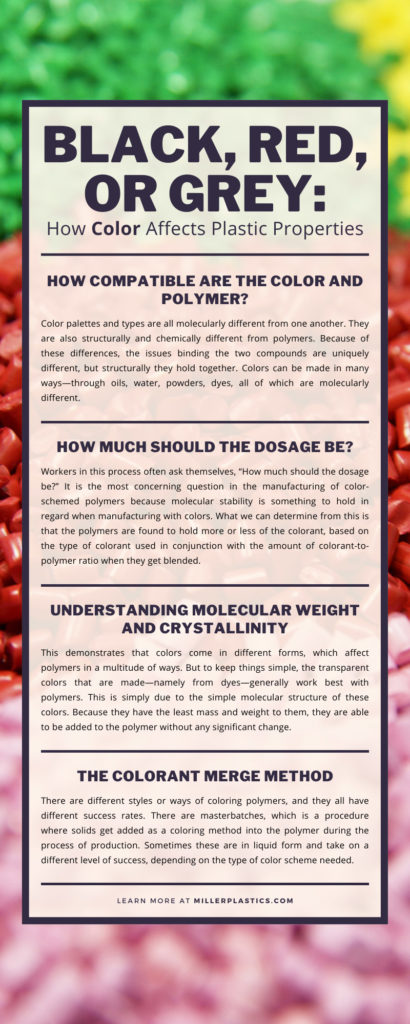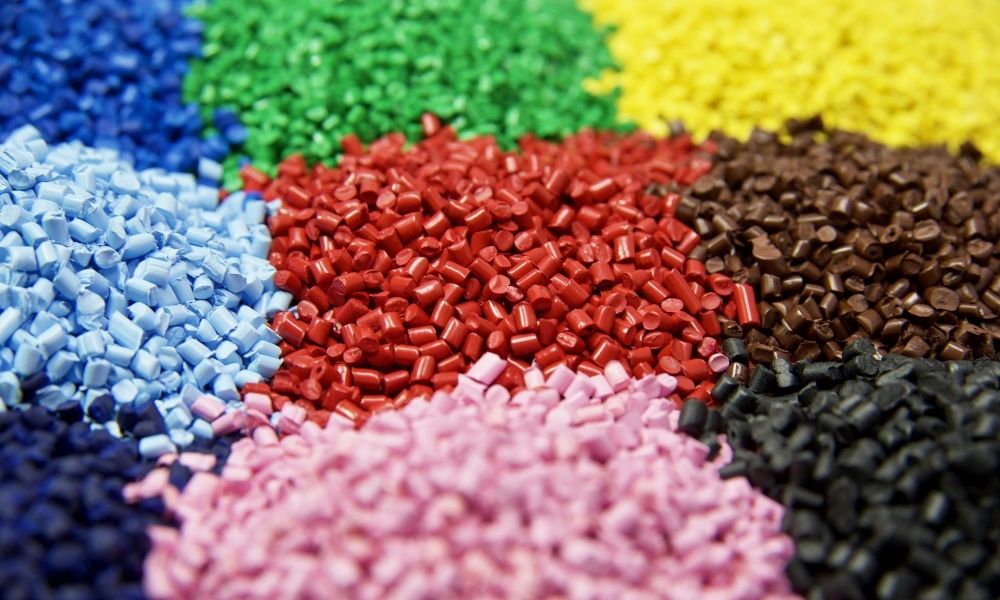Plastic production is more detailed than most people believe. Whenever colors or material substance is added to polymers, bonds of the polymer become weakened. Certain colors and matter have a greater molecular bond with polymers than others. Understanding the connection between the two substances requires a mastery of science and technology. It’s why only plastics manufacturers are able to handle these compounds and how they work together to create colored polymers. Continue reading to learn how color affects plastic properties.
How Compatible Are the Color and Polymer?
Color palettes and types are all molecularly different from one another. They are also structurally and chemically different from polymers. Because of these differences, the issues binding the two compounds are uniquely different, but structurally they hold together. Colors can be made in many ways—through oils, water, powders, dyes, all of which are molecularly different. Some polymers are made softer and others harder, all for different purposes. Depending on the purpose, the molecular makeup determines which colors might work well with which polymers. One thing to be aware of, however, is that the polymer’s structural integrity doesn’t break down due to the properties of the colorant and polymer mixture.
One way of processing is to blend colorants into polymers through the process of high heat injection. This means that the effect of the colorant is greatly reduced and weakened while the polymer is being colored. This means that, before this processing, tests are performed that ensure the polymers are compatible enough to not affect the colorant properties. If both tests are successful, then you have achieved a method that works to take both and blend them perfectly without sacrificing the properties of one or the other. This also means that both the polymer and the colorant have to have the same levels of integrity under high temperatures. It is difficult for both of them to be compatible with one another. Even with the compatibility present, however, this process isn’t always the answer. At a high temperature, certain color effects and visual appearances can be skewed while others will not.
How Much Should the Dosage Be?
Workers in this process often ask themselves, “How much should the dosage be?” It is the most concerning question in the manufacturing of color-schemed polymers because molecular stability is something to hold in regard when manufacturing with colors. What we can determine from this is that the polymers are found to hold more or less of the colorant, based on the type of colorant used in conjunction with the amount of colorant-to-polymer ratio when they get blended. The colorant holds a dichotomy of roles; for instance, it helps preserve the polymer on one end by not destroying it. This can only be done by using certain weights and measurements. Additionally, it also serves as a contaminant in the process. This also has a great impact on how much is being processed at one time. If your polymer is able to produce only one quarter of its mass of the colorant per batch, that subjects the process of making the same amount per batch. This quantifies the size of the production, which then determines how much you are able to make daily. Keep these things in mind as they regulate production beyond an indefinite amount.
Understanding Molecular Weight and Crystallinity
This demonstrates that colors come in different forms, which affect polymers in a multitude of ways. But to keep things simple, the transparent colors that are made—namely from dyes—generally work best with polymers. This is simply due to the simple molecular structure of these colors. Because they have the least mass and weight to them, they are able to be added to the polymer without any significant change. Other colorants, however, can drastically change the outcome of the polymer’s overall structure of mass, weight, and form. This has been a huge breakthrough in how color-schemed polymer production is done and what materials should be used in making them. For these same reasons, custom plastic parts manufacturers are put in place to produce these products due to their specificity.
The Colorant Merge Method
There are different styles or ways of coloring polymers, and they all have different success rates. There are masterbatches, which is a procedure where solids get added as a coloring method into the polymer during the process of production. Sometimes these are in liquid form and take on a different level of success, depending on the type of color scheme needed. Another way of coloring polymers is composites. In this technique, you take two or three composite types of materials—typically polymers and colorants—and blend them together to get a product that is more durable than the original items used. Surface coatings get cured or dried on the surface of the polymer. This is done in the preservation of the polymer compound for strength and durability, and it would not be possible through heat reinforcement treatment. There’s another process called dry blends, and in it, blow molders, extrusion molders, injection, and rotation are used to coat the polymer. So, now you know all the rules for compatibility and what works when it comes to blending polymers with colorants. You also know the other factors that contribute to processing color-coded polymers. This article has demonstrated that not all polymers are created equal. Some require a colorant agent to mold and process the polymer to result in a desirable end product. From this article, you can see how the relationship between color and plastic properties is complicated and fascinating. So much care goes into the production of the materials so the batches will turn out right. Without this knowledge, it may be impossible to create colored polymers. Without this process, the plastics that we know today may have turned out entirely different.





